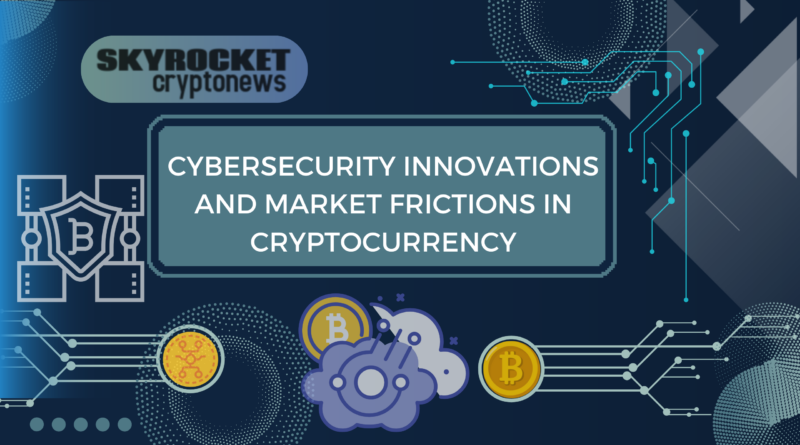Cybersecurity Innovations and Market Frictions in Cryptocurrency
The beginning of cryptocurrency has reshaped the financial landscape, offering remarkable possibilities and dangers. As digital assets become increasingly integrated into mainstream finance, the twin challenges of cybersecurity and market frictions have come to the forefront. This blog explores how cybersecurity innovations are evolving to meet the needs of the cryptocurrency market while addressing the inherent market frictions that impact investors and traders.
The Evolving Cybersecurity Landscape in Cryptocurrency
Cryptocurrencies function on decentralized networks, leveraging blockchain technology to guarantee transparency and security. However, the very characteristics that make cryptocurrencies appealing also introduce new vulnerabilities. Cybersecurity in this space is not just about protecting digital assets; it’s about safeguarding trust in an emerging financial system.
1. Multi-Signature Wallets and Hardware Security Modules
One of the most significant improvements in cryptocurrency security is the use of multi-signature (multi-sig) wallets. These wallets require multiple private keys to permit a trade, adding an extra layer of security. For instance, a wallet might require signatures from three out of five possible keyholders, making it substantially more difficult for a single compromised key to result in theft.
Additionally, hardware security modules (HSMs) are becoming increasingly crucial. These physical devices store private keys in tamper-resistant surroundings, significantly reducing the threat of cyber invasions. By combining HSMs with multi-sig technology, cryptocurrency exchanges, and wallet providers can enhance their security frameworks.
2. Smart Contract Audits and Bug Bounties
As cryptocurrencies and decentralized applications (dApps) rely heavily on smart contracts, ensuring their security is paramount. Regular audits by specialized firms are now a standard practice. These audits help identify vulnerabilities and weaknesses before they can be exploited. For example, Ethereum’s smart contract ecosystem benefits from continuous scrutiny by firms like ConsenSys Diligence and Quantstamp.
Moreover, the bug bounty schedules incentivize autonomous security investigators to find and report exposures. This crowdsourced approach leverages the collective expertise of the community, further strengthening the security posture of cryptocurrency projects.
3. Zero-Knowledge Proofs and Privacy Technologies
Privacy is another critical aspect of cryptocurrency security. Zero-knowledge proofs (ZKPs) allow one group to prove to another that a piece of detail is true without revealing any details above the validity of the information itself. Technologies such as zk-SNARKs (Zero-Knowledge Succinct Non-Interactive Arguments of Knowledge) and zk-STARKs (Zero-Knowledge Scalable Transparent Arguments of Knowledge) are enriching privacy on blockchain networks by enabling personal commerce.
Market Frictions in Cryptocurrency Markets
While cybersecurity innovations address the protective measures needed for cryptocurrencies, market frictions represent the inefficiencies and challenges within the cryptocurrency trading ecosystem. These variances can impact liquidity, pricing, and public market efficiency.
1. Liquidity and Spread Issues
One significant friction in cryptocurrency markets is liquidity. Unlike traditional financial markets, many cryptocurrency exchanges suffer from low liquidity, particularly for less popular coins. This low liquidity can result in wide bid-ask spreads, making it costly for traders to enter and exit positions. Market makers and liquidity providers are increasingly stepping in to address these issues, but liquidity remains a challenge.
2. Regulatory Uncertainty and Compliance
The regulatory circumstances for cryptocurrencies are still growing, with different countries adopting mixed perspectives. This regulatory apprehension creates discord in the market, affecting how institutions engage with digital assets. Compliance with anti-money laundering (AML) and know-your-customer (KYC) regulations adds complexity for exchanges and can slow down transactions, impacting user experience and market efficiency.
3. Fragmentation Across Platforms
Cryptocurrency trading often involves navigating multiple exchanges and platforms, each with its interface, fee structure, and trading options. This fragmentation can usher in inefficiencies and more elevated marketing costs. Innovations such as decentralized exchanges (DEXs) and cross-chain platforms aim to reduce fragmentation by offering integrated solutions that facilitate seamless trading across different blockchain networks.
4. High Volatility and Market Manipulation
Cryptocurrency markets are notoriously volatile, with prices subject to rapid and unpredictable swings. This volatility can be heightened by market manipulation tactics, such as pump-and-dump schemes and spoofing. The introduction of more sophisticated trading tools and algorithms, along with improved regulatory oversight, is critical in mitigating these frictions and ensuring a fair trading environment.
Bridging the Gap: Future Prospects
The meeting of cybersecurity and market efficiency in the cryptocurrency space offers both challenges and opportunities. As the technology evolves, so too will the strategies to address these issues. Enhanced security measures, coupled with innovations to reduce market friction, will be pivotal in shaping the future of cryptocurrency markets.
1. Advanced Security Protocols
Looking ahead, the development of quantum-resistant algorithms will become increasingly important. As quantum computing betterment, it has the potential to break current cryptographic benchmarks. Investing in quantum-safe technologies will ensure that cryptocurrencies remain secure in the face of future threats.
2. Integration of AI and Machine Learning
Artificial intelligence (AI) and machine learning are poised to revolutionize both cybersecurity and market analysis. AI can help in detecting fraudulent activities and anomalies in real time, while machine learning algorithms can improve market predictions and trading strategies. The integration of these technologies will enhance both security and market efficiency.
3. Global Regulatory Frameworks
The establishment of cohesive global regulatory frameworks will be crucial in addressing market frictions. A harmonized approach to regulation can reduce uncertainty and create a more stable environment for investors and institutions. Collaboration between governments, regulatory bodies, and industry stakeholders will be essential in achieving this goal.
Conclusion
As cryptocurrency continues to evolve, the synergy between cybersecurity innovations and efforts to address market frictions will play a critical role in shaping its future. By advancing security measures and tackling inefficiencies, the cryptocurrency industry can pave the way for a more robust, secure, and efficient financial ecosystem. Navigating these challenges successfully will be key to unlocking the full possibility of digital assets and fostering trust in this transformative technology.

